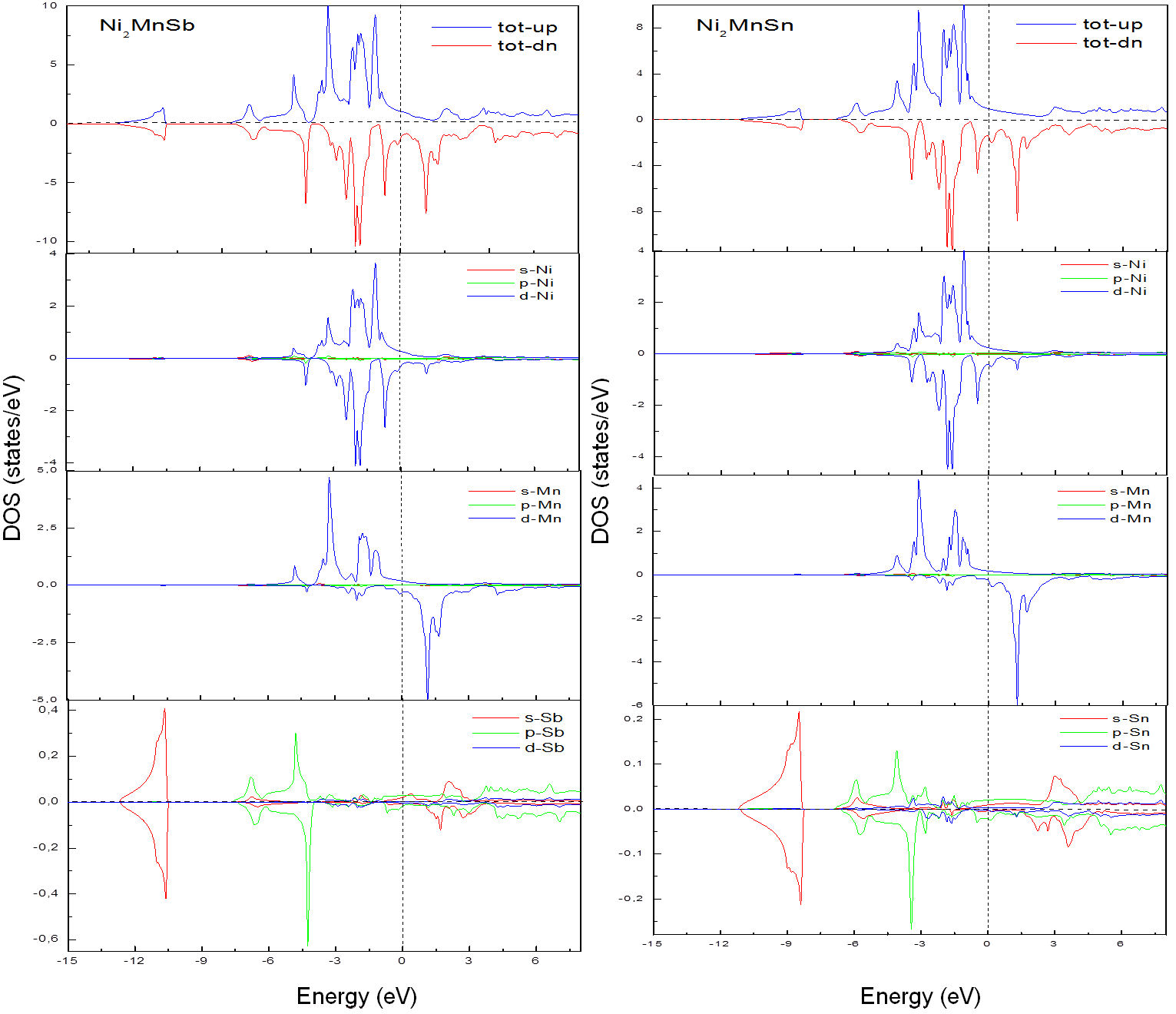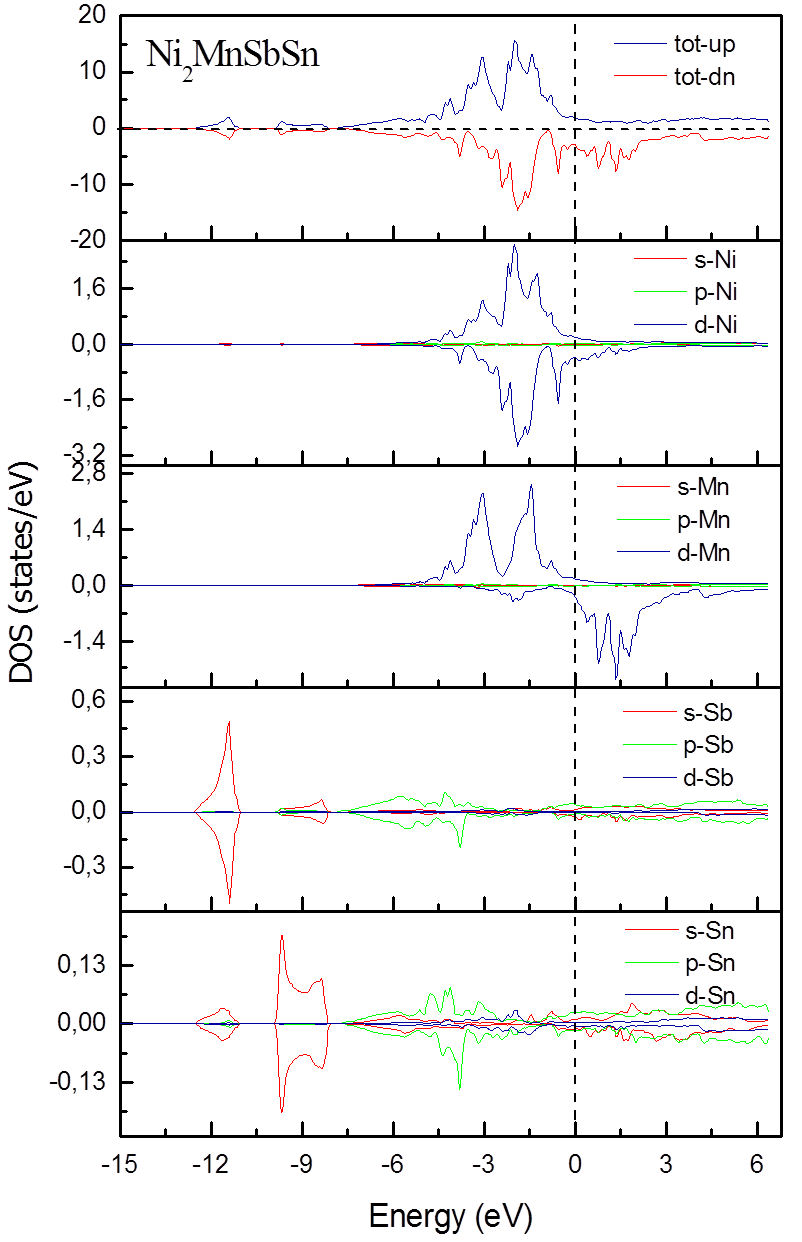1. Introduction
Recently, tremendous experimental and theoretical interest arose for Ni-based Heusler alloys because of two unique properties that they exhibit: shape memory effect and inverse magneto caloric effect. Indeed, due to their extraordinary magneto-elastic properties as actuators and sensors [1-3], magnetic shape memory alloys (MSMA) are good candidates for future technological applications. A MSMA, Ni2MnGa has been studied extensively [4-8]. Despite its outstanding properties, Ni2MnGa has a relatively low Curie and martensitic transformation temperature, high brittleness, its Gallium constituent expensive, etc. Nevertheless, Ni2MnSb and Ni2MnSn alloys with composition close to stoichiometric Heusler structure are promising ferromagnetic MSMA [9,10]. This is due to the fact that Ni2MnSn and Ni2MnSb alloys have martensitic transformation domain close to room temperature, a requirement for technological applications. Full Heusler quaternary alloys of the type X2Y1−xYxZ, X2YZ1−xZx and (X1−xXx)2YZ have been extensively studied. Galanakis studied a series of Heusler alloys (Co2[Cr1−xMx]Al, Co2Mn[Al1−xSnx], and [Fe1−xCo2]MnAl) [11]. Ahmadian et al. investigated the bulk Co2Ti1−xFexGa Heusler alloys and Co2Ti0.5Fe0.5Ga (001) surfaces, electronic and magnetic properties [12]. Some first-principles electronic structure calculations have been done on Ni2MnX (X=Sn, Sb) systems, with the idea of realizing new MSMA’s with better performances than that of Ni2MnGa. Most of the calculations were focused on these alloys compressibilities [13]. Hydrostatic effect on Curie’s temperature (TC) has been experimentally studied with pressure [10]. Gavrillunk performed Ni2MnSn isothermal compressibility and Mossbauer high-pressure experiment [14]. Şaşioğlu et al. investigated Ni(1−x)MnSb system exchange interactions and Curie’s temperature [15]. Very recently, Benichou et al. [16] have studied the electronic structure, elastic, and magnetic properties of quaternary Heusler alloy Cu2MnSn1−xInx (x = 0, 0.25, 0.5, 0.75, 1) using an ab-initio calculation by substituting the main group element (Sn by In) in this compound. The Cu2MnSn1−xInx alloy is found to be ferromagnetic, metallic compound, brittle, and anisotropic in nature.
The aim of this paper is to provide a detailed study of the structural, elastic, electronic, and magnetic properties for Nickel based Heusler compounds and to study Ni2MnSb0.5Sn0.5 quaternary alloy. In Sec. 2, we outline our computational procedure. The results are discussed in Sec. 3 and summarized in Sec. 4.
2. Computational procedure
Using spin polarized density functional theory (DFT) [17,18] with full potential linear augmented plane wave plus local orbitals (FP-LAPW+lo) method as implemented in the WIEN2k code [19], we determine total energy and electronic structure. Perdew-Burke-Ernzerhof generalized gradient approximation (PBE-GGA) [20] is used to get the exchange correlation potential. Wave functions are expanded up to angular momentum lmax = 10 inside the muffin-tin spheres. The Gmax parameter was taken to be 12.0. Convergence parameter RMT*KMAX is set to 7.0. RMT is the smallest MT radius and KMAX is the magnitude of the largest K vector in plane wave expansion. Ni, Mn, Sb, and Sn atoms radii are set to 2.2, 2.0, 1.9 and 1.9 a.u. (atomic units), respectively. Total and partial densities of states are calculated by tetrahedral integration method [21]. The self-consistent calculations were considered to be convergent when the total energy was stable within 0.1 mRy. Mesh of 104 and 4 special Brillouin zone (BZ) k-points were used in the irreducible wedge of the BZ for the parent ternary and quaternary compounds, respectively. The cut-off energy was chosen to be -8 Ry. The full-Heusler alloys have cubic L21 (Cu2MnAl-type) structure with the space group Fm-3m-225. The lattice contains four interpenetrating fcc sublattices at positions (0,0,0) for Mn, (1/4,1/4,1/4), (3/4,3/4,3/4) for Ni and (1/2,1/2,1/2) for Z (Z = Sb, Sn). In order to simulate Ni2MnSbSn quaternary alloy, a Ni2MnSb original unit cell was extended to an eight-atoms supercell by substituting one Sb atom by one Sn atom. This corresponds to 0.5 doping concentration for both Sb and Sn atoms.
3. Results and discussion
3.1. Structural and elastic properties
Ni2MnSb, Ni2MnSn, and Ni2MnSb0.5Sn0.5 compounds structural properties are calculated. Total energy variation with volume was fitted to the Murnaghan equation of state [22] to obtain the equilibrium lattice constant and bulk modulus. Results are listed in Table I along with the available theoretical and experimental data. Good agreement is found theoretical and experimental data. Good agreement is found with the available data [13,23-28], with the exception of the quaternary alloy. Total energy under compression for all alloys is plotted in Fig. 1. The ferromagnetic state is found to be more stable than corresponding non-magnetic state for all materials presented.
TABLE I Calculated values for the lattice parameter (a), bulk modulus (B) and its pressure derivative (B’) for Ni2MnSb, Ni2MnSn, and Ni2MnSb 0.5Sn 0.5 compounds.
| Compounds | a(Å) | B(GPa) | B’ | |
| Ni2MnSb | NM | 5.9384 | 179.6488 | 5.2373 |
| FM 6.0515 | 137.226 | 5.2916 | ||
| 6.00 [13] | 168.3 [13] | 6.00 [13] | ||
| 6.004 [23] | 139.7 [25] | |||
| 6.051 [25] | ||||
| Ni2MnSn | NM | 5.9433 | 185.2524 | 4.2997 |
| FM | 6.0426 | 145.7315 | 4.7048 | |
| 5.92 [13] | 168.5 [13] | 2.9 [13] | ||
| 6.053 [23] | 140 [24] | 4.89 [25] | ||
| 6.068 [25] | 138.4 [25] | |||
| 6.06 [28] | 146.38 [28] | |||
| Ni2MnSb 0.5 Sn 0.5 | NM | 5.9712 | 216.0407 | 6.0765 |
| FM | 6.0798 | 168.9919 | 5.3129 |

FIGURE 1 Variation of calculated total energy as a function of lattice constant for Ni2MnSb, Ni2MnSn, and Ni2MnSb 0.5 Sn 0.5 compounds for both non-magnetic and ferromagnetic phases.
To the best of our knowledge, there are no comparable studies about Ni2MnSbSn in the literature. So, we have estimated the lattice constant by utilizing the Vegard’s law in Eq. (1),
Elastic constants for all three materials are computed at room pressure using the Charpin method, developed and integrated in WIEN2k [29]. Stability criteria for cubic crystals requires [30]:
The three independent cubic crystal elastic constants are given in Table II. Bulk modulus, calculated from of elastic constants B = (1/2)(C 11 + C 12) theoretical values are listed in Table II; it has nearly the same value as the one obtained from energy minimization. C 11, C 12, and C 44 agree quite well with available theoretical results for Ni2MnSb and Ni2MnSn. However, due to experimental difficulties in preparing martensite single crystals, only few reliable complete sets of low symmetry martensite phases in MSMAs elastic constants are reported.
TABLE II Elastic constants in (GPa), bulk modulus (GPa), C’ and A for Ni2MnSb, Ni2MnSn, and Ni2MnSb 0.5Sn 0.5 compounds.
| Compounds | C 11 | C 12 | C 44 | B | C’ | A |
| Ni2MnSb | 161.97 | 148.41 | 89.49 | 153.20 | 6.78 | 13.20 |
| 143.7 [25] | 137.7 [25] | 74.924[25] | 3.0 [25] | 24.97[25] | ||
| Ni2MnSn | 168.76 | 140.23 | 78.32 | 150.00 | 14.26 | 5.49 |
| 161.02[26] | 128.5 [25] | 87 [24] | 145.31[26] | 14.8 [25] | 5.49 [25] | |
| 158.1 [25] | 137.46[26] | 81.3 [25] | 138.4 [25] | 8 [24] | 11 [24] | |
| 158.12 [28] | 128.41[28] | 92.56 [26] | ||||
| 81.28 [28] | ||||||
| Ni2MnSb 0.5 Sn 0.5 | 155.74 | 131.33 | 63.62 | 139.47 | 12.20 | 5.21 |
Concerning the stability criteria, we note that Eq. (2) is satisfied by Ni2MnSb, Ni2MnSn, and Ni2MnSb 0.5 Sn 0.5 . Material stability is better described by two other parameters shown in Table II: Shear constant, defined as C’ = 1/2(C 11 − C 12) and elastic anisotropy ratio A, given by A = C 44 /C’. The values of C’ and A for all three studied compounds lie well within the limits observed in shape memory alloys MSMA [25,31-34]. No experimental or theoretical data for the elastic constants of the quaternary alloy Ni2MnSb 0.5 Sn 0.5 are available in scientific literature; therefore, we expect our results to provide baseline data for future investigations.
3.2. Electronic and magnetic properties
In their stable magnetic structure, Heusler compounds Ni2MnSb and Ni2MnSn total and partial density of states calculations are shown in Fig. 2.
Overall, band shapes in all couple of compounds are similar. It is also seen that both majority and minority bands cross the Fermi level in almost all high symmetry directions; thus, confirming a metallic ferromagnetic character. Like most Heusler alloys containing Ni2MnGa, a pseudo-gap is formed below Fermi level. As for Ni2MnGa, we see a double peak structure very close to Fermi level (Fig. 2). According to Barman et al. [35], this double peak plays a crucial role in favoring martensitic transition. Moreover, we note that the (−4.5 eV; +3 eV) bands for Ni2MnSb (Ni2MnSn) in both majority and minority spin states are mainly due to d states hybridization of Mn and Ni atoms. The (−12 eV; −10.5 eV) bands are caused by Sb (Sn) atoms s states, while (−7.5 eV; −4.5 eV) bands are due to Sb (Sn) atoms p states.
Figure 3 shows calculated Ni2MnSb 0.5 Sn 0.5 total and partial DOS. DOS shape has changed slightly from parent compounds. Peaks are very sharp. This quaternary alloy is metallic. Bands around -12 eV and -4 eV are due to Sn and Sb atoms s and p states. The energy range between −5 eV and +2.5 eV is governed by Ni and Mn atoms d states hybridization.
Calculated Heusler compounds Ni2MnSb and Ni2MnSn total and local magnetic moments are listed in Table III, together with available theoretical data [13,15,24,25,27,28].
TABLE III Calculated total and local magnetic moments in (µB) for Ni2MnSb, Ni2MnSn, and Ni2MnSb 0.5Sn 0.5 compounds.
In general, good agreement is found. In this work, calculated spin magnetic moment distribution shows that Ni2MnSb and Ni2MnSn are ferromagnetic with magnetic moment of Ni parallel to that of Mn, while a very small anti-aligned moment is observed for Sb and Sn atoms. Table III shows that the total magnetic moment, which includes the interstitial region contribution comes mainly from Mn atoms for both compounds (3.39 µB for both Ni2MnSb and Ni2MnSn). The robust Mn moment character results from the large exchange Mn 3d states splitting. It is important to notice that only one spin projection Mn 3d states (spin-up) are “strongly” occupied. The spin-down Mn 3d states main part lies above Fermi level. According to Şaşioğlu [36], who used Anderson s − d mixing model [37], there is a variety of magnetic behavior in Mn-based Heusler alloys that can be interpreted in terms of competition between ferromagnetic RKKY-type exchange and antiferromagnetic superexchange. For Ni2MnSb 0.5 Sn 0.5 , the total spin magnetic moment is calculated by integration over the entire cell. We notice that the total moment has increased from its parent compounds. Even for Mn and Ni spin moments, we observe a slight increase.
4. Conclusion
We investigated structural, elastic, electronic, and magnetic properties for Ni2MnSb, Ni2MnSn, and Ni2MnSb 0.5 Sn 0.5 alloys using (FP-LAPW+lo) method within GGA. Our results showed good agreement with available data. Elastic constants are numerically estimated and good agreement is found with other calculations. We predict that quaternary alloy Ni2MnSb 0.5 Sn 0.5 is likely a candidate for martensitic transformation. Thus, it seems possible to obtain alloys exhibiting martensitic transformation and possibly magnetically controlled shape memory effect by alloying in a small amount of Sb or Sn. We hope that our work proves to be useful for future experiments on spintronic field measurements, and provide a guide for experimentalists working in this field.











 nueva página del texto (beta)
nueva página del texto (beta)




